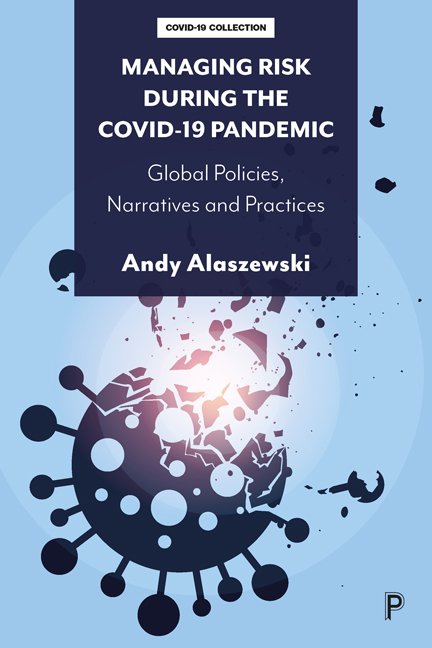Book contents
- Frontmatter
- Dedication
- Contents
- List of tables
- List of abbreviations
- About the author
- Acknowledgements
- Foreword
- Preface
- 1 Introduction: risk as a key feature of late modern societies
- PART I Responding to the challenges of the pandemic
- PART II Mitigating risk through science and technology
- PART III Risk narratives
- References
- Index
Preface
Published online by Cambridge University Press: 20 January 2024
- Frontmatter
- Dedication
- Contents
- List of tables
- List of abbreviations
- About the author
- Acknowledgements
- Foreword
- Preface
- 1 Introduction: risk as a key feature of late modern societies
- PART I Responding to the challenges of the pandemic
- PART II Mitigating risk through science and technology
- PART III Risk narratives
- References
- Index
Summary
This book developed out of my interest in risk. Since the mid-1990s, I have concentrated my academic work on risk and society.
In 2008, I was invited to join the UK Scientific Advisory Group on Pandemic Influenza (SPI) convened by the Department of Health, a precursor of the current scientific advisory groups on pandemics. At committee meetings, we considered the risk and impact of a global flu pandemic on the UK (high) and the effectiveness of possible responses (probably limited). The three groups of experts on the committee each advocated a different approach to reducing the risk of a pandemic:
• Scientists with expertise in microbiology or pharmacy supported the development of vaccines to prevent infection or mitigate symptoms. This can be problematic as flu and other viruses tend to mutate rapidly, so vaccines have limited efficacy against new variants.
• Behavioural scientists advocated behavioural changes, such as improving personal hygiene, covering coughs and sneezes, and hand washing. It was not clear how easy it would be to improve personal hygiene or how effective these measures would be in limiting the spread of a highly infectious virus that spread from person to person by aerosol spray.
• Epidemiologists and risk experts (I formed part of this group) focused more on evidence from past pandemics, especially the 1918– 1919 Spanish flu pandemic and the role that reducing social contact played in reducing the spread of the virus. In the US, cities that shut down and reduced social activity quickly and stayed shut down the longest had the lowest death rates, whereas cities that did not shut down or delayed shutting down and reopened quite quickly had a higher death rate.
During a pandemic, the global spread of a deadly disease, it was probable that the virus causing the disease would be carried into the UK by international travellers and then distributed by public transport systems and large-scale gatherings. The most effective way of controlling its spread was to control access through ports and airports and to reduce social interactions on public transport and at large public events. In a pandemic, it would be important to warn the public, especially the most vulnerable such as older people, so they could take action to protect themselves.
- Type
- Chapter
- Information
- Managing Risk during the COVID-19 PandemicGlobal Policies, Narratives and Practices, pp. xvii - xxPublisher: Bristol University PressPrint publication year: 2023



